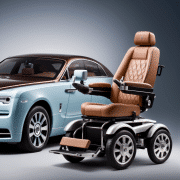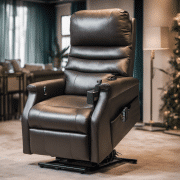Wheelchair Parts: Parts of a Wheelchair You May Need To Replace
A wheelchair is a complex mobility device intricately composed of numerous wheelchair parts and accessories, each playing a vital role in its overall operation and the comfort of the user. Central to its design is the frame, which provides the foundational structure of the wheelchair. The movement is facilitated by various elements like the wheels,...


A wheelchair is a complex mobility device intricately composed of numerous wheelchair parts and accessories, each playing a vital role in its overall operation and the comfort of the user. Central to its design is the frame, which provides the foundational structure of the wheelchair. The movement is facilitated by various elements like the wheels, which comprise the front casters and rear wheels, and for manual wheelchairs, hand rims are included. The seating system, consisting of a backrest and cushion, alongside other wheelchair accessories such as footrests and armrests, collectively contribute to the user’s comfort. For electric wheelchairs, additional integral parts include the motor and battery system.
Wheelchair accessories are additional elements that can enhance the functionality, comfort, and convenience of a wheelchair. These range from simple add-ons like cup holders and bags to more complex components like pressure-relieving cushions and adjustable headrests. Other accessories can include:
- Wheelchair ramps for easier accessibility.
- Weather-resistant covers for protection.
- Specially designed gloves for manual wheelchair users.
For electric wheelchairs, extra batteries, chargers, or advanced control systems can be considered accessories. These wheelchair accessories improve the user experience and personalise the wheelchair to the individual’s unique needs and preferences.
Understanding the Anatomy of a Wheelchair: Maintenance, Replacement, and Upgrades
Wheelchairs, whether manual or electric, are essential mobility devices that can improve the quality of life for individuals with mobility limitations. Like any other mechanical device, understanding the various parts of wheelchairs and their roles in their functionality is crucial. This article provides an in-depth look at wheelchair anatomy, common replacement parts, factors to consider during replacement, and the cost implications.
Common Parts of a Manual Wheelchair That May Need to Be Replaced
Due to wear and tear, certain parts of a manual wheelchair may need to be replaced over time. These can include the tires, which can wear down or puncture; the hand rims, which can become damaged; and the upholstery, which can tear or sag. Other parts like brakes, armrests, and footrests may also require replacement due to frequent use.
Common Parts of an Electric Wheelchair That May Need to Be Replaced
Electric wheelchairs, while more complex, also require part replacements. The batteries typically need to be replaced every 1-2 years, depending on usage. Motors can wear out, and control systems like joysticks can become less responsive or break. Tires, armrests, and seating systems are also common replacement parts.
Factors to Consider When Replacing Wheelchair Parts
When replacing parts of a wheelchair, it’s important to consider compatibility with your wheelchair model, the quality of the replacement part, and the cost. Always choose parts designed for your specific wheelchair model to ensure proper fit and functionality.
DIY Versus Professional Replacement of Wheelchair Parts
While some parts, like cushions or tires, can be replaced at home, others, such as motors or control systems in electric wheelchairs, may require professional help. Always consider your ability and comfort level with the task, as improper installation can affect the wheelchair’s performance or even safety.
Finding the Right Replacement Parts for Your Wheelchair
Finding the right replacement parts can be done through the wheelchair manufacturer, speciality mobility stores, or online. Always ensure the parts are compatible with your specific model and come from a reputable source to guarantee quality. This is the same when looking for replacement parts for walkers.
Proper Maintenance and Care for Wheelchair Parts
Regular maintenance can extend the lifespan of wheelchair parts. This includes cleaning, checking for wear and tear, and making necessary adjustments or replacements. Regular battery checks for electric wheelchairs and tire checks for all wheelchairs can prevent sudden breakdowns.
Cost of Replacing Wheelchair Parts
The cost of replacing parts for wheelchairs can vary significantly based on the specific component, the model of the wheelchair, and whether you’re installing the part yourself or using a service technician.
For instance, simpler parts like wheelchair wheels can cost anywhere from $50 upwards, depending on the type and quality. A new cushion can range from $80 for a basic model to over $1,000 for a high-end, pressure-relieving variant. Armrests and a wheelchair footrests can also vary widely in price.
When it comes to electric wheelchairs, the costs can increase significantly due to the complexity of the parts. Batteries typically need replacing every 1-2 years, depending on the model. A motor might cost several hundred dollars, and a control system such as a joystick could be up to a few hundred dollars.
Remember, labour costs for professional installation can also add to the total price. It’s always wise to request a quote before committing to a service. Furthermore, it’s crucial to note that while cheaper parts may be tempting, investing in high-quality parts can save money in the long run, reducing the frequency of replacements and potential damage caused by substandard parts.
Finally, checking whether your insurance or a warranty covers part of these costs is worth looking into. Some healthcare plans or manufacturers’ warranties may cover specific wheelchair parts, repairs and replacements, so always check your coverage before purchasing.
Upgrades and modifications to a wheelchair can significantly enhance both performance and comfort, making it more tailored to the user’s specific needs and lifestyle.
For improved performance, consider upgrading the wheels or casters. Different terrains may call for specific types of wheels. For example, larger rear wheels can make self-propulsion easier, while softer wheels can provide a smoother ride over bumpy surfaces. For electric wheelchairs, upgrading to a more powerful motor or a longer-lasting battery can improve speed and range.
Comfort can be improved with a variety of upgrades. A new cushion, for instance, can provide better support and pressure distribution, reducing the risk of pressure sores. Ergonomic armrests or adjustable footrests can make a significant difference in seating comfort. Additionally, consider upgrading the backrest for better postural support.
There are also various accessories designed to increase convenience and comfort. For example, adding a cup holder, a bag for personal items, or an umbrella holder can make daily tasks easier.
For individuals with specific physical needs, there are specialised modifications available. These might include alternative control systems for electric wheelchairs, such as sip-and-puff controls for those with limited upper body movement, or elevating seat mechanisms for users who need help reaching higher surfaces.
Keep in mind that while upgrades and modifications can greatly enhance a wheelchair, it’s crucial to discuss these changes with a healthcare or mobility professional. This ensures that the changes are suitable for your specific health needs and that they won’t affect the wheelchair’s balance or safety.
Preferred Suppliers for the Healthcare Industry Since 2003
Patient Handling is founded on a sound base of great staff, great products and great partners. We strive to put our clients needs above all else and focus on well thought out solutions for complex needs.



Receive latest news
Contact Us
We are an online store only. Please contact us if you would like a product specialist to assist with your purchase.









